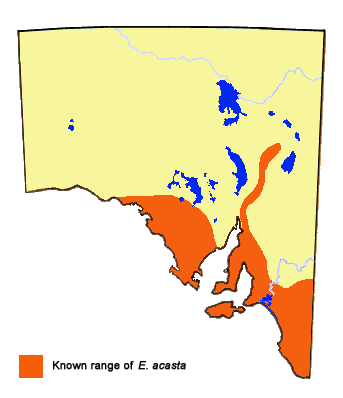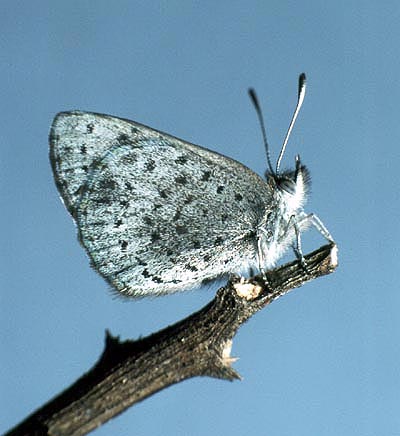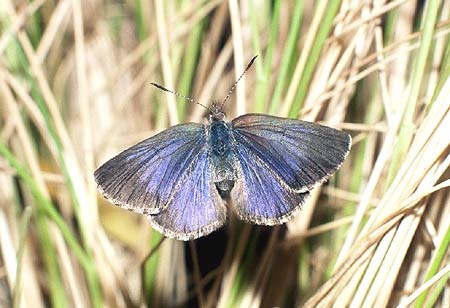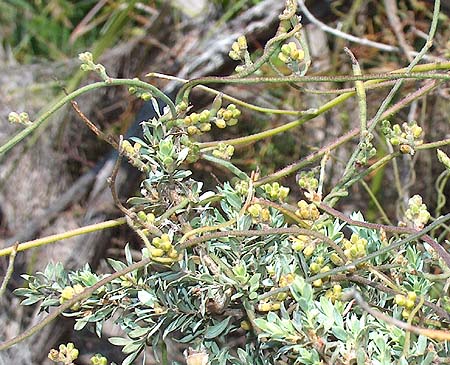-
Larval Food Host
-
Cassytha glabella form dispar (slender dodder-laurel),
C. peninsularis var. flindersii (Flinders Range dodder-laurel),
C. peninsularis var. peninsularis (streaked or peninsula dodder-laurel),
C. pubescens (downy or rusty dodder-laurel) (Lauraceae).
The larvae are known to eat only the flower buds of the hostplant.
-
Larval Attendant Ant
-
The larvae are usually not attended by ants, although in some areas they may
be accompanied by one or two small ants.
-
Eggs
-
Small, initially pale green, later turning white, hemispherical, top rounded,
base flattened, with a coarsely reticulated, raised pattern which is continuous
to the micropylar area. The reticulations are irregular, consisting of shapes
varying from quadrangular to hexagonal, with each reticulation intersection
having a small raised blunt projection. Laid singly on the hostplant, usually
on the flower buds, but sometimes on the tendrils. The eggs hatch in about
4-5 days in summer.
-
Larvae
-
The first instar is initially, pale yellow. After eating, it changes colour to
greenish yellow, and eventually acquires some pinkish markings. Onisciform shaped,
and the head is large, smooth, yellowish green, hidden beneath the body. The posterior
dorso-lateral organs are not developed. There are long dark dorsal setae, and long pale
peripheral setae that are longest anteriorly and posteriorly. Dorsal setae occur in
two pairs, one pair being long and recurved, the other pair being short, recumbent and
directed to the rear. Later intermediate instars are similarly coloured to the final
instar, and gradually lose the long hairs.
The final instar is about 11-12 mm long, onisciform shaped with a weak thoracic dorsal
furrow, the lateral edges are only slightly scalloped, the anterior end is rounded, the
posterior end is flattened and pointed (angular), and there are some short dorsal and
peripheral hairs.The head is small, smooth, greenish yellow, hidden beneath the
body. The body is covered in numerous, minute, dark coloured secondary setae having
a protuberant,angular and ridged base and a long, serrated and pointed central
spine. Coloured in some shade of green, with dark green dorsal and subdorsal lines,
the latter stopping short of the final posterior segments and which is broadly edged
dorsally in white or pale yellow. The area between the dorsal line and the white
edging is infilled with a paler green colour than the rest of the body, giving the colour
effect of a broad dorsal band. There are sometimes additional pink markings
anteriorly and subdorsally. The larval period is about 3-4 weeks in mid-summer.
Larvae generally feed at night, hiding during the day in leaf debris within the
hostplant or on low herbage of the hostplants near the ground. A larva is very
immobile when feeding on the flower bud, which it does by initially eating a small hole
into the side of the small bud then progressively inserts its head (and sometimes the
forward part of its body if it is still an early instar), into the bud and gradually eats
out the stamen contents, until the bud is reduced to an empty shell. The larva then
becomes mobile again as it moves to the next bud.
-
Pupae
-
Have a shape typical for the Candalides tribe, but more narrow than usual and with
less ornamentation, about 8-10 mm long, roughly triangular in cross-section, with a weakly
developed abdominal dorsal ridge. A divided pointed dorsal projection occurs on the thorax.
The lateral part of the abdomen and anterior edge of the head is flattened, with the head
flange divided at the front and noticeably extended anteriorly. Greenish at first, but
later turning to various shades of pale brown or grey, with additional darker brown and
black fine cryptic markings, sometimes with a dark brown dorsal line, and there are also
some black markings along the edge of the abdominal flange. The dorsal bifid projection
is white. Weakly attached by the cremaster and a central girdle, to dead leaf and other
debris within or around the base of the plant, or beneath the bark of the host plant. The
pupae are easily dislodged, so many must end up on the ground within leaf debris.
The pupal period is variable, and can be as short as 9 days in summer, but pupae produced
in late summer and autumn, usually remain dormant until the following early spring.
-
Flight Period in South Australia
-
The butterfly flies from early August to early May. Main flights tend to coincide
with the flowering of the hostplants, which are necessary for the larvae to mature.
As a brood can be completed in about 5-6 weeks, it is likely there are three or
more broods completed into late summer, so long as the hostplants are still producing
flowers. Some male butterflies also hibernate over winter, reappearing on the odd
warm day to sun themselves and have a feed.

-
Distribution
-
The butterfly is usually found wherever its hostplants occur in sufficient density,
and these are widespread and locally common. It also occurs on Kangaroo Island.
In the Flinders Ranges it occurs on the high plateaus. It is usually very rare
in the Lower Southeast Region, but can sometimes be locally common along the coastal
dunes if its hostplants are present. Also recorded generally from southern temperate
Australia, including Tasmania.

-
Habitat
-
In South Australia its hostplants grow in a variety of habitats, but particularly
in heathland/shrubland, woodland and the wetter mallee, and they seem to require
a minimum annual rainfall in excess of about 300 mm. The butterfly favours the
more pristine habitats of its hostplants.
-
Conservation Status in South Australia
-
Locally common.
-
Threats
-
Its main threats are from bushfires, urban development and agricultural activities.
The parasitic hostplants are sometimes considered damaging to other plants,
particularly in the urban environment, and are therefore removed.
-
Conservation Strategy
-
Healthy native trees seem to be able to tolerate the parasitic dodder hostplant,
and there is usually a self-induced balance between the tree host and the dodder.
If there appears to be an imbalance in the urban environment, then it may be
possible to thin out some of the dodder, rather than remove it totally.
An active Candalides colony will help keep the dodder pruned or considerably
reduce the amount of fruit it can produce. Dodder forms an important part of
the remnant flora of road verges, and these should be left alone as they sometimes
contain small colonies of the butterfly.




